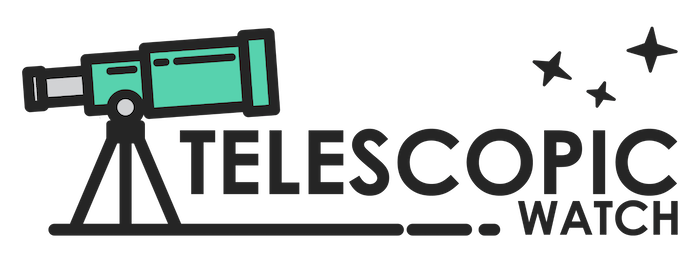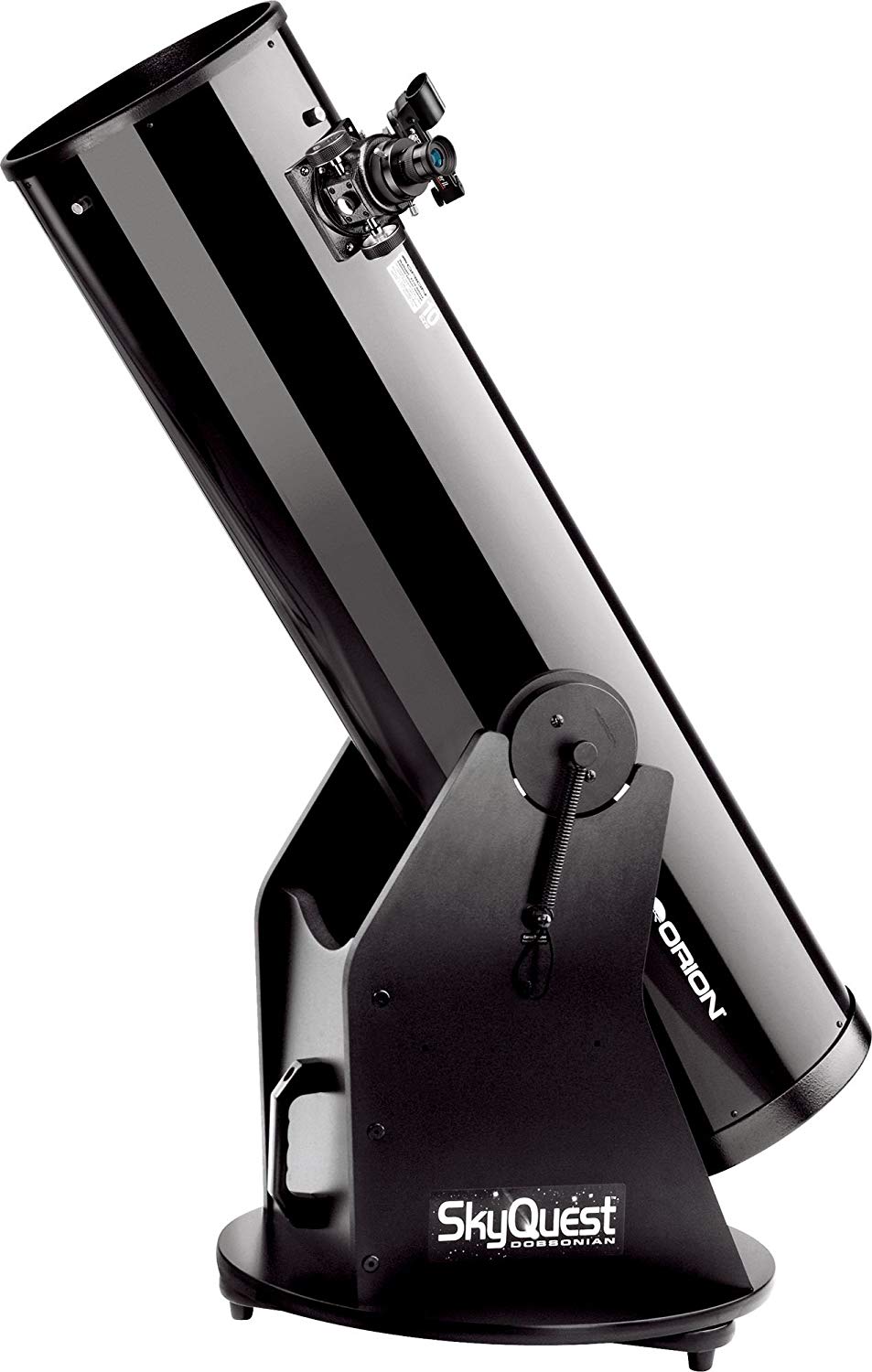The Optical Tube Of Orion SkyQuest XT10
The SkyQuest XT10 is a 10” (251mm) f/5.1 Newtonian reflector with a focal length of 1270mm.
This moderately fast focal ratio of f/5 means that collimation of the mirrors is more challenging, with lower tolerances.
More importantly, the fast focal ratio also means that the telescope doesn’t perform very well with cheap eyepieces. For instance, a cheap 2″ wide-angle eyepiece, such as an Erfle or “SuperView” design, which works moderately well in f/6 or longer-focal-length telescopes, is not going to be sharp all the way to the edge of the field of view in the XT10. But the good thing is that if you’re looking at deep-sky objects for the first time, you might not notice such optical aberrations like coma and astigmatism that come with these less expensive eyepieces.
As you gain more experience and become more critical of the XT10’s optical performance, you could ideally get a coma corrector such as the Explore Scientific HR Coma Corrector or Tele-Vue Paracorr to use with this scope, but the former is significantly expensive and the latter costs almost as much as the whole telescope. If you can find a good deal on a coma corrector and some well-made wide-field eyepieces, you’ll really get the most of what the XT10 has to offer and pinpoint stars from one edge of the field of view to the other.
The XT10 has a 2″ single-speed Crayford focuser with a compression ring to fit 2″ eyepieces or the included 1.25″ adaptor, which doesn’t have a compression ring but has T-threads to attach a camera.
A not on portability
The XT10’s large, awkward, and smooth metal tube makes it somewhat difficult for me to carry especially since there’s nowhere to grab onto except the bearings and the ends of the tube. I almost always add a handle or straps of some kind to such thick tubes, which helps tremendously.
The tube fits across the back seat of most cars, so I see the portability as no worse than a 6” or 8” dobsonian telescope.
The Lone Eyepiece, Red Dot Finder, & My Recommendations
The XT10 comes with a lone 1.25″, 25mm Plossl eyepiece for low power. While it is functional, I’d prefer at least one or two extra eyepieces for lower and higher magnifications to use on a variety of different targets.
- The first thing I’d recommend you go out and buy for the XT10 is a 6mm “goldline” eyepiece for 200x magnification, which is optimal for the Moon and planets even on less-than-steady nights.
- After that, a good low-power wide-angle eyepiece like the 30mm GSO Superview would be a good choice in the medium price segment.
- Over time, you could also get 9-11mm and 13-15mm eyepieces to fill the “gaps” in magnifications and perhaps a very short focal length eyepiece than the 6mm goldline for even higher power.
The XT10’s supplied red-dot finder works, but you might want something that makes it easier to find deep-sky objects than the stock red-dot finder. I’
Mount
The XT10’s mount is made of melamine-covered particle board. While cheap and functional, if damaged it’s hard if not impossible to repair, and furthermore if damaged it will quickly warp and rot due to moisture seeping in. Also, it’s heavy compared to a plywood or hardwood mount.
The XT10 uses Orion’s spring tensioning system to balance properly with heavy eyepieces even though its altitude bearings are small (we’ll get to this in a moment), which works reasonably well but doesn’t allow for adjusting the tension (ease of movement) in altitude.
The bearing pads are made of Nylon instead of genuine Teflon and the laminate is just melamine rather than Formica or Ebony Star laminate. While this isn’t a problem with the smaller XTs, it leads to less-than-ideal motion, particularly at high power and in altitude. The scope’s tiny altitude bearings don’t aid this, either, as the massive 30-lb weight of the telescope’s tube pivots down on just a few square inches of area.
You can order real Teflon and cut some pads out of it for less than $30 (use brads and a hammer to nail it in place) and nail a piece of scrap Formica to the bottom of the azimuth bearing. These improvements will mostly fix the sticky, squeaky bearings, though the scope’s altitude motions will never be quite perfect.
Should I buy a Used Orion XT10?
Check to make sure that the coatings are in good shape and the particleboard base is not rotted. If the coatings are worn, a recoat (typically a couple of hundred US dollars) is needed, while a damaged base will need to be replaced (fairly easy and inexpensive to do with plywood and basic woodworking tools, or you can buy one from third parties).
Alternative Recommendations
At the same price as the Orion XT10, you might want to consider other similar Dobsonians that are a bit more well-equipped:
- Apertura AD10/Zhumell Z10/Orion SkyLine 10 – Better focuser and bearings, more accessories.
- Meade LightBridge Plus 10” – Better focuser plus a significantly more portable truss design with a collapsable base.
- Orion XT8i – A bit less aperture, but better accessories and a computerised pointing aid system.
Aftermarket Accessory Recommendations
The first thing we’d recommend you go out and buy for the XT10 is a “6mm “goldline” eyepiece for 200x magnification, optimal for the Moon and planets even on less-than-steady nights. After that, a good low-power wide-angle eyepiece like the 30mm Meade UHD or 30mm GSO Superview would be a good choice. Over time, you could also get 9-11mm and 13-15mm eyepieces to fill the “gaps” in magnifications and perhaps a very short focal length eyepiece for even higher power than the 6mm goldline provides.
Additionally, you might want something that makes it easier to find deep-sky objects than the stock red-dot finder. We’d recommend a Telrad reflex sight for the XT10. It works similarly to a red-dot finder, but projects a bullseye with various degree circles instead of a dot and has a more transparent and larger window to look through.
What can you see?
One of the first telescopes I ever looked through was an XT10 (actually, two of them). These scopes are often decried as mere “light buckets,” only useful for deep-sky observation, but they perform quite favourably on the Moon, planets, and other high-resolution targets as well.
In fact, it is the largest aperture that only has to put up with one atmospheric “air cell,” that is, one column of turbulent air. A scope any larger than 10” is looking through multiple air cells and will suffer more from bad atmospheric “seeing” as a result.
The Moon is fantastic in a 10” telescope, with craters down to a couple kilometres in diameter visible.
Mars, when it reaches opposition, shows up to an astounding two dozen dark markings (areas of darker sand and rocks on the planet’s surface) as well as its ice caps. If timed correctly and if one places the Red Planet just outside the field of view, Mars’ outer moon Deimos is a pretty easy catch, while Phobos can be spotted on rare occasions (though I’ve yet to do so) if one can shield it from Mars’ bright glare.
The asteroid (4) Vesta can just barely be surmised as non-stellar on an excellent night when it is closest to Earth and is a brilliant gold colour.
Jupiter’s moons are not only disks with a 10” scope, but they actually begin to show little bits of colour. Io is a nice orange-yellow, Europa is a faded white, and Ganymede and Callisto are brownish-grey.
Saturn’s moon Titan is clearly more than a star-like point and is a distinct yellow-orange colour (which results from methane smog in its upper atmosphere). Saturn itself will show numerous cloud bands and about a half dozen other moons.


